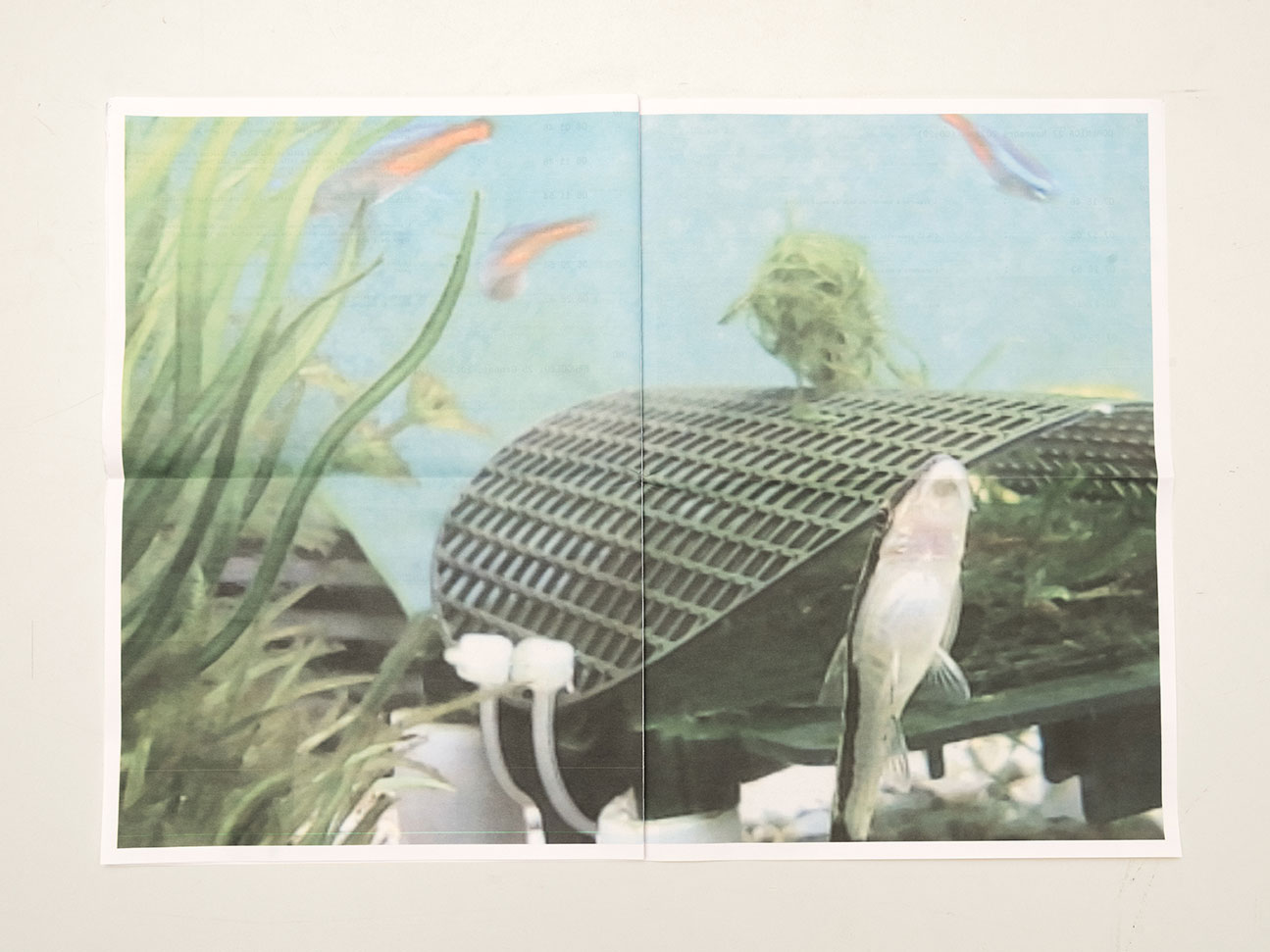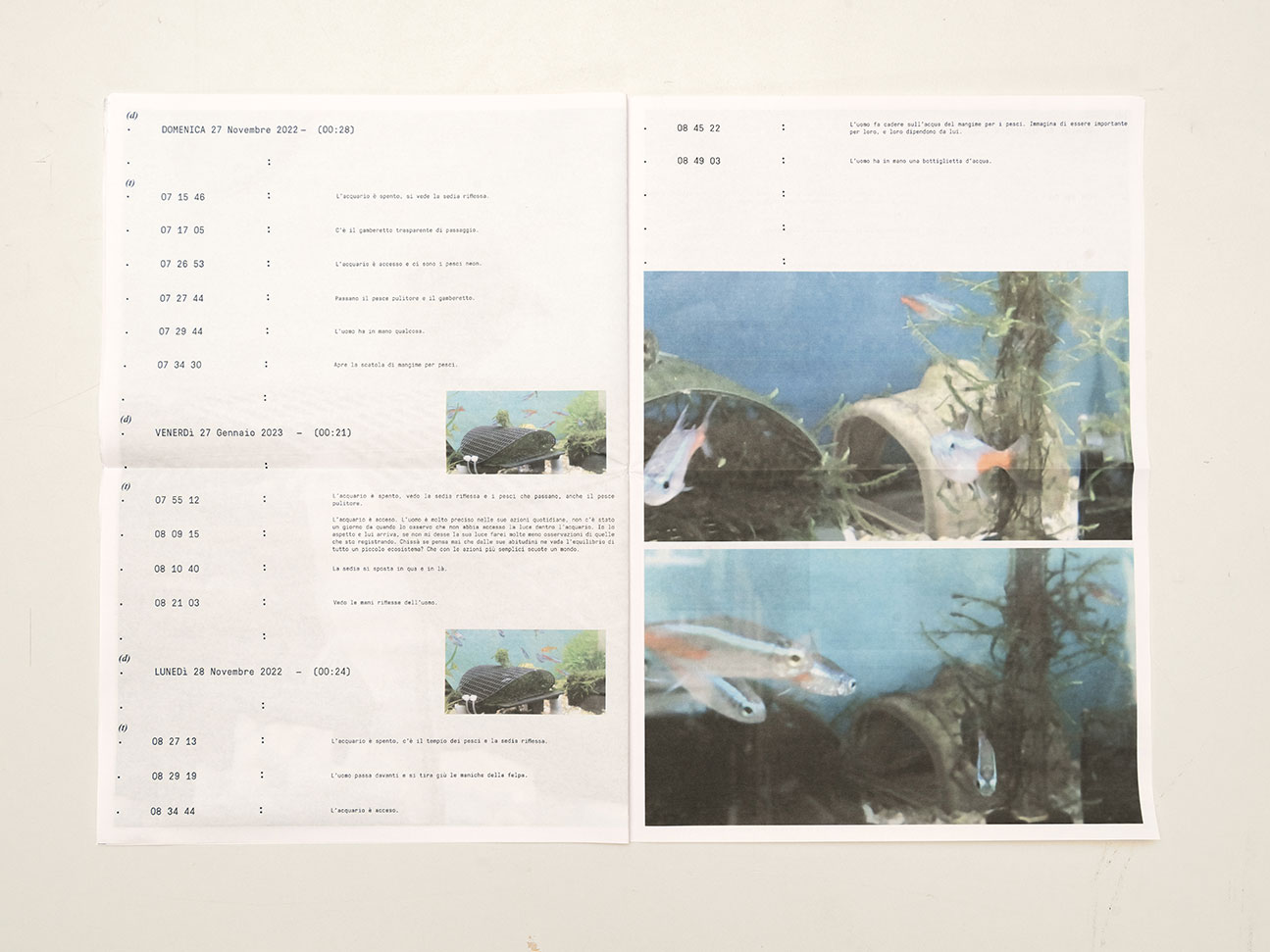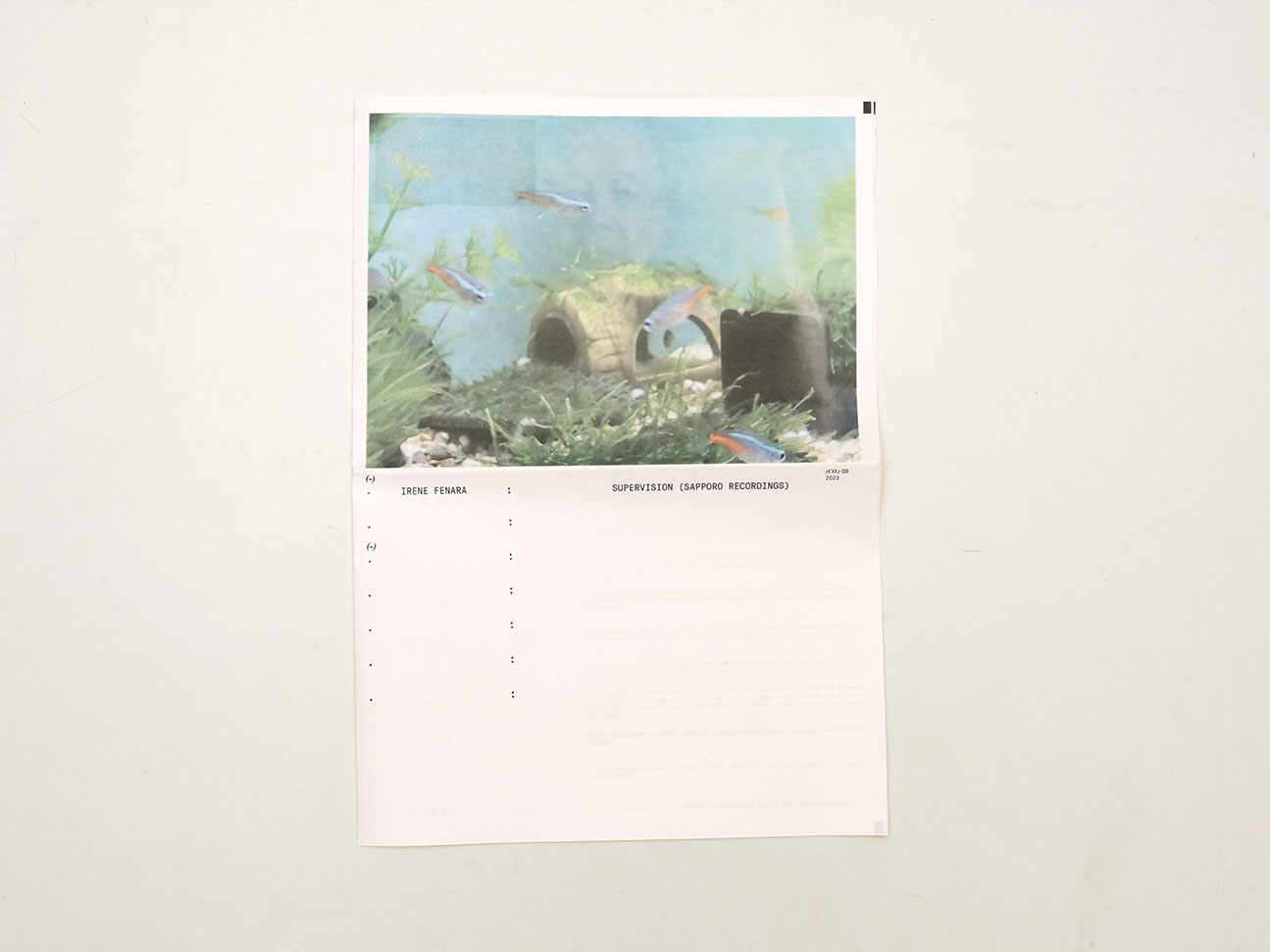




CONDYLURA08
w/IRENE FENARA
2023
Edition of 100
20 pages
Broadsheet
design by Marco Casella (Visivo std.)
10 € BUY
Condylura publishes a free digital copy at sold-out
*
The condylura adopts the mechanical eye of a security camera pointed at the aquarium of a man in Sapporo, Japan, from whose glass we also discover reflected the artist, who for months watched and recorded a minimal daily routine, yet filled with life: between us there are almost twelve thousand kilometers, a lens, a glass, water and another glass.
TEXT
A security camera, pointed at the aquarium of a man in Sapporo, Japan. Irene Fenara secretly accesses it from her studio, following a nighttime routine that we discover lasts for many months. She records, through both images and writing, the minimal yet constant transformations of that stream: the fish inhabiting it, the landscape of algae, its light and color variations. But also the life of the man, glimpsed in fleeting moments reflected on the glass. Supervision (Sapporo edition) was born as a video work, a flow of images selected from the long process of capture, which finds a new way of revealing itself in the publication—as an observation journal, the log where the screenshots and annotations have been collected over the months.
Supervision is the title of the broader photographic series that Irene Fenara has been developing since 2018, based on the appropriation of images from surveillance cameras. Through a borderline hacking practice—the artist accesses the cameras without forcing their security—Fenara selects shots from the continuous stream of recordings, saving from the oblivion of automatic deletion images that are constantly generated but rarely, if ever, seen. The series, particularly focused on views of natural and urban landscapes, captures fleeting apparitions such as plays of light and shadow, reflections, and optical phenomena that give rise to dreamlike and fantastic, but also eerie and ghostly images. A poetic system that also includes pixelated textures, chromatic aberrations, blurs, and machine malfunctions. The images traverse visual culture, evoking both artistic references and media—even cyber—aesthetics. Like the Sapporo edition aquarium, which simultaneously recalls a painterly study of light and color, a symbolic figure of a surveilled and simulated reality, and an icon of digital-age since the early-2000s Windows screensavers.
Fenara's practice navigates the complexities of the digital network, slipping into the cracks of computational architectures and revealing a system of hidden or semi-hidden dynamics, which she investigates both visually and systematically. The Supervision photographs are characterized by an oblique, withdrawn perspective on the world, mirroring the positioning of surveillance cameras themselves. Her work inevitably engages with contemporary issues of control, but from a visual cultural standpoint, rather than a social critique. The closed-circuit networks that Fenara opens up are not meant to comment on secrecy or mass surveillance; instead, they belong to a culture where cameras have become an integral part of our daily life. There is no psychology of the artist, no voyeurism, nor an affirmation of critical commentary—rather, a scopic drive to incorporate the machine, unveiling new horizons of the optical unconscious in an era where most images are produced by machines for other machines, beyond human perception, cognition, and agency. This is the (super)vision of a machinic eye that discreetly produces a third nature, in which traditional art-historical and photographic genres—landscape, abstraction, self-portrait—take on new significance, opening up a world beyond the human.
Humans never appear in Supervision; they are an absent subject. Paradoxically, this also applies to the distinct but connected series Portraits from Surveillance Camera, in which Fenara portrays herself by physically entering the surveillance frame and posing for the camera. The artist follows an identical formula for the posture and attire, becoming a cipher, a unit of measurement—when exhibited, the photos vary in format to keep the printed size of her body constant. It is a process of codification of the self, conceptually linked to her photographic practice but also infused with a pop-cultural charge, Matrix-style, like the total-black figure appearing in the frame. In Sapporo edition, the human presence makes an unexpected intrusion, emerging on the screen after many observation sessions, triggering an immediate short circuit despite the minimal manifestations—a hand entering the frame, a sweater draped over a chair—culminating in the spectral epiphany of a reflected face in the aquarium.
Supervision (Sapporo edition) carries its own voyeuristic and reflective temperature, differing from the cooler tone of the Supervision photographic series—already evident in the video and further highlighted by the reading. This journal allows us to follow the process of observation, which begins as a routine expressed in meticulous and repetitive descriptions, almost disturbing for the unwavering attention to the image and its minimal variations. It is a clinical, machinic approach—akin to the image itself—but also deeply personal and intimate, as a near-secret relationship between artist and subject gradually emerges, mirrored by the literary genre of the diary. The writing that informs the images oscillates between analysis and self-referentiality, constructing an emotional landscape—both aquatic and digital—where the artist’s presence, though invisible, becomes palpable. Through the text, we end up encountering imaginative leaps into the lives of the fish and the man, as well as moments of introspection. In those moments, Irene Fenara seems to linger on her own act of observation, discovering herself reflected in that same glass, which becomes screen, mirror, and prism—a projection of presences that find a world within an intricate web of observation and self-observation: between us there are almost twelve thousand kilometers, a lens, a glass, water and another glass.
